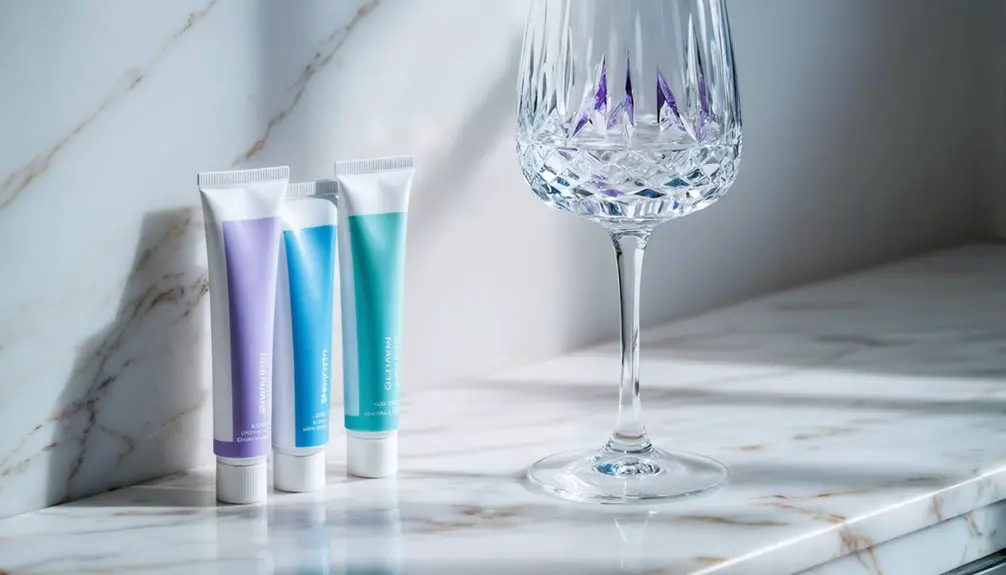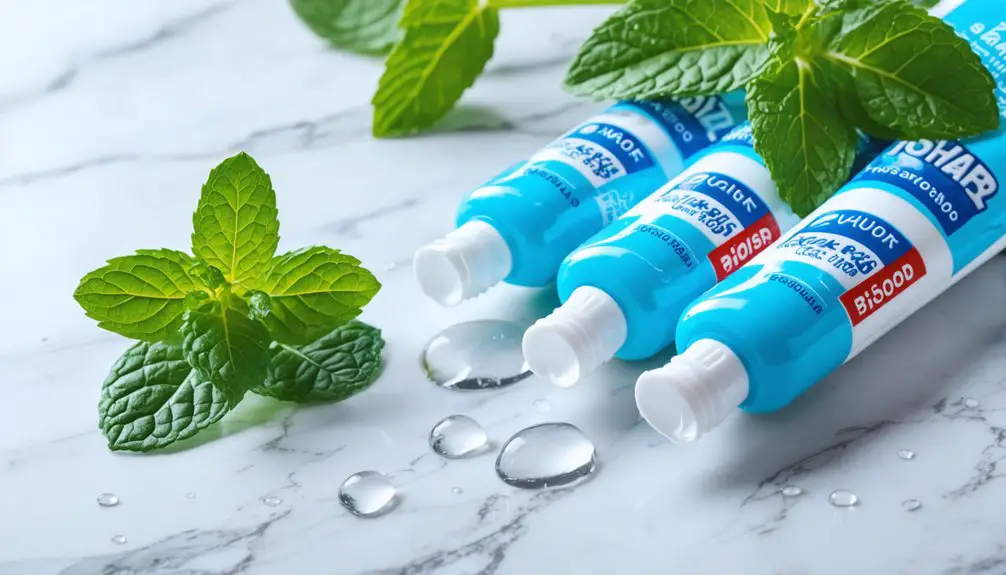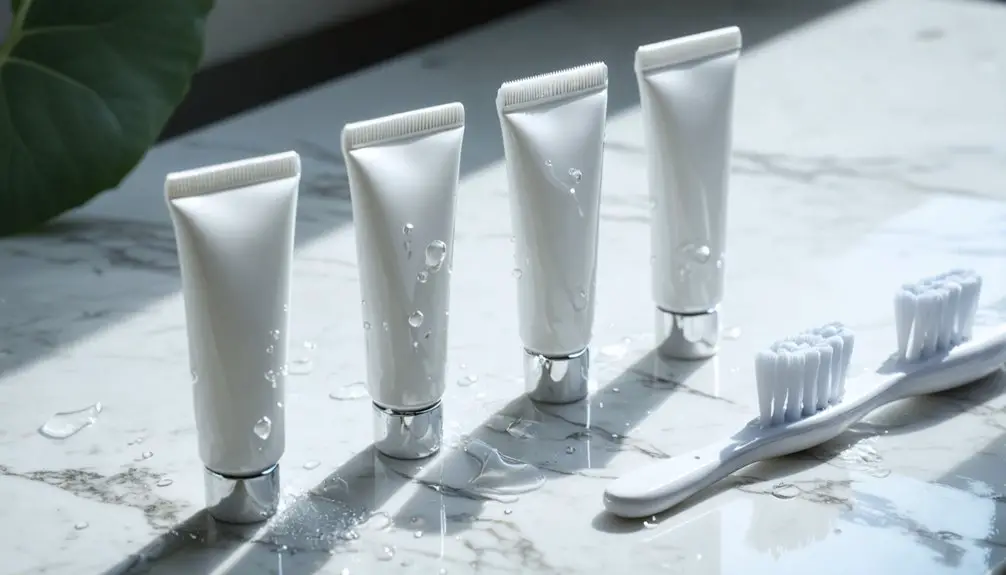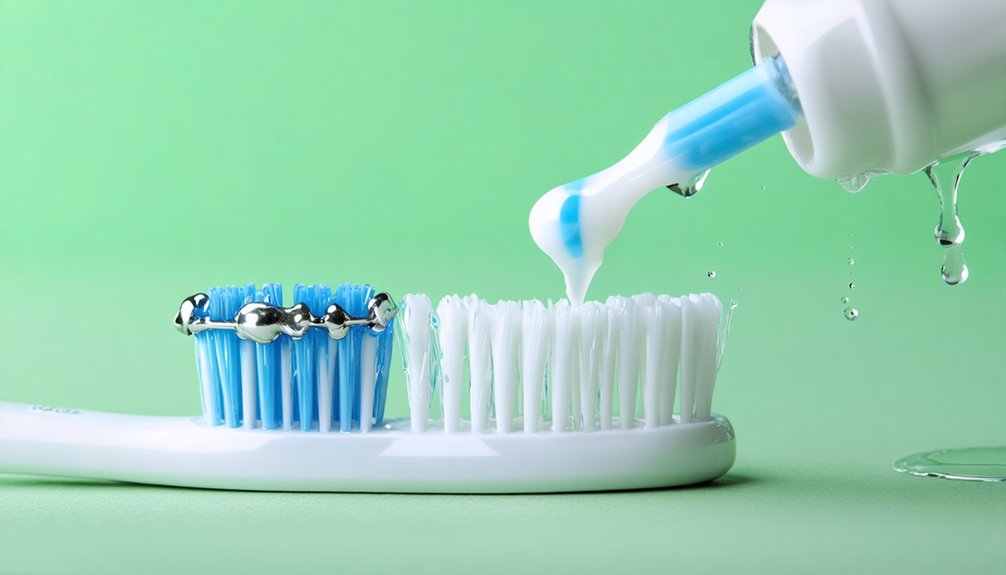To effectively combat wine stains, you’ll want to choose a toothpaste with specific stain-fighting ingredients like dual silica systems and hydrogen peroxide. Colgate Optic White Stain Fighter offers 5X more whitening power than standard toothpaste, while natural enzyme-based options provide gentler alternatives for sensitive teeth. Wait 30 minutes after drinking wine before brushing, and always look for the ADA seal of acceptance. Our extensive guide reveals additional proven strategies for ideal results.
Key Takeaways
- Colgate Optic White Stain Fighter provides 5X more whitening power and contains hydrogen peroxide for effective wine stain removal.
- Toothpastes with dual silica systems and hydrated silica are most effective at removing surface stains from wine.
- Look for products containing sodium hexametaphosphate and proteolytic enzymes, which specifically target and break down wine pigments.
- Natural toothpastes with baking soda offer gentle stain removal for sensitive teeth while protecting weakened enamel.
- Choose ADA-accepted whitening toothpastes that combine fluoride protection with stain-fighting ingredients for long-term results.
Understanding How Wine Stains Affect Your Teeth
While many people enjoy wine, its effects on dental health can be significant and complex. When you drink wine, especially red varieties, the combination of phosphoric acid and chromogens creates conditions for stain formation on your teeth. The acid temporarily weakens your enamel, allowing pigmented molecules to attach to the roughened surface. Research from New York University found that soaking teeth in white wine for one hour made them significantly more susceptible to staining.
You’ll notice that red wine causes more visible staining due to its high tannin content, while white wine primarily contributes to enamel erosion. This erosion makes your teeth more susceptible to staining from other beverages like coffee and tea. Rinsing with water after drinking wine can help minimize potential staining effects.
The process primarily affects the outer surface of your teeth through extrinsic staining, rather than causing internal tooth changes. If you’ve recently had your teeth bleached, you’ll be particularly vulnerable to wine stains, as the altered enamel surface more readily attracts pigments.
Best Professional-Grade Whitening Toothpastes
When selecting a professional-grade whitening toothpaste for wine stain removal, you’ll find advanced formulations that combine multiple active ingredients for excellent results.
Look for products containing dual silica systems and hydrated silica, which effectively target wine discoloration while safely polishing your enamel.
Advanced whitening toothpastes with dual silica systems effectively combat wine stains through gentle polishing action, protecting your enamel while brightening your smile.
For peak whitening effectiveness, choose toothpastes with hydrogen peroxide and chemical stain modifiers like sodium hexametaphosphate. These ingredients work together to break down existing stains and provide stain prevention. Colgate Optic White Stain Fighter delivers 5X more whitening compared to regular non-whitening toothpaste.
Professional-grade options with ADA acceptance marks offer clinically proven safety and results. A two-step system like Crest 3D White Brilliance can deliver up to 99% of professional polish whiteness.
Consider formulations that include potassium nitrate if you’re concerned about sensitivity.
When advising clients, recommend brushing twice daily for two minutes using gentle circular motions, and suggest briefly delaying rinsing to maximize the whitening agents’ contact time.
Natural and Gentle Options for Sensitive Teeth
For those with sensitive teeth, natural toothpaste formulations offer gentler alternatives to professional-grade whitening products.
You’ll find baking soda and enzyme-based options that provide natural whitening without harsh abrasives. These formulations incorporate papain and bromelain enzymes to break down wine stains while protecting your enamel. Wait thirty minutes after drinking wine before using these products to prevent potential enamel damage. Regular use of these products helps combat surface stains that form when tannins bind to teeth.
Look for products containing gentle abrasives combined with soothing ingredients like aloe vera and tea tree oil, which offer anti-inflammatory benefits during the whitening process.
For enhanced protection, choose formulations with remineralizing compounds such as calcium phosphates or nano-hydroxyapatite. These ingredients strengthen your enamel while fighting stains.
If you’re sensitive to fluoride, numerous fluoride-free options contain natural enamel-repair properties that effectively combat wine discoloration while maintaining your comfort and oral health.
Key Ingredients That Combat Red Wine Stains
Understanding the chemistry behind red wine stain removal requires familiarity with key toothpaste ingredients that target discoloration.
You’ll find abrasive agents like silica and calcium carbonate that physically lift stains through gentle mechanical action, while chemical agents such as sodium pyrophosphate and hydrogen peroxide break down pigmented molecules.
Your toothpaste’s effectiveness relies on the synergistic action of multiple components.
Proteolytic enzymes digest protein layers where wine pigments attach, while surfactants enhance stain dispersion. Using an electric toothbrush can maximize the effectiveness of these stain-fighting ingredients. The presence of acidic tannins in red wine makes regular brushing especially important.
Anti-redeposition compounds, including polyphosphates, prevent stains from reattaching to your teeth.
For ideal results, look for formulations that combine these active ingredients with fluoride, which strengthens enamel and supports long-term stain resistance.
The most effective products balance these components without risking enamel damage.
Tips for Maximum Stain-Fighting Results
Armed with knowledge of toothpaste’s stain-fighting components, you’ll need specific techniques to maximize their effectiveness against wine stains. For ideal dental hygiene and stain prevention, apply toothpaste directly to dried wine stains and let it sit for several hours. Let the toothpaste dry completely and you’ll see optimal stain removal. Choose a gentle formula if you’re treating sensitive teeth or delicate fabrics.
Apply toothpaste with care and let it sit to effectively combat wine stains while protecting sensitive teeth and fabrics.
Using fluoride toothpaste provides added protection against future stains while strengthening tooth enamel.
Enhance your results by incorporating an electric toothbrush with whitening mode, which removes surface stains more effectively than manual brushing.
Don’t forget to floss daily, as it eliminates trapped pigments between teeth that brushing can’t reach. For long-term protection, maintain consistent twice-daily brushing and consider using a dentist-recommended whitening kit.
Remember to brush with moderate pressure using soft bristles to protect your enamel while fighting those stubborn wine stains.
Frequently Asked Questions
How Long Should I Wait After Drinking Wine Before Brushing My Teeth?
Even if you’re keen to remove stains, wait 20-30 minutes after drinking wine before brushing. Wine acidity effects soften enamel, and this delay guarantees proper enamel protection through saliva’s natural remineralization.
Can Whitening Toothpaste Remove Old Wine Stains From Years Ago?
You won’t achieve effective whitening of years-old wine stains with whitening toothpaste alone. These products lack the concentration needed for deep old stain removal. Professional treatments offer more reliable results.
Will Whitening Toothpaste Work on White Wine Stains Too?
You’ll see limited whitening effectiveness on white wine stains since they’re more erosive than pigmented. While whitening toothpaste aids in stain prevention, it’s best for surface maintenance rather than removing old discoloration.
Should I Brush Before or After Using a Wine Stain-Removing Spray?
Let your pearly whites rest before reaching for your brush. You’ll want to apply the wine stain removal spray first, wait a few minutes for the ingredients to penetrate, then brush to maximize stain-fighting effectiveness.
Can I Use Multiple Whitening Toothpastes Together for Better Results?
You shouldn’t combine whitening toothpastes, as multiple products won’t improve whitening effectiveness. Different toothpaste ingredients can interact negatively, increasing sensitivity and risking permanent enamel damage through overexposure.
References
- https://crest.com/en-us/oral-care-products/toothpaste/3d-white-stain-eraser-whitening-toothpaste-fresh-mint?bvstate=pg:5/ct:r
- https://www.the-independent.com/extras/indybest/fashion-beauty/beauty/best-whitening-toothpaste-uk-reviews-b1783716.html
- https://www.colgate.com/en-us/products/toothpaste/colgate-optic-proseries-toothpaste
- https://www.cnet.com/health/personal-care/best-whitening-toothpaste/
- https://pmc.ncbi.nlm.nih.gov/articles/PMC9683888/
- https://slotownsmiles.com/blog/red-vs-white-wine-teeth-whitening/
- https://www.nature.com/articles/sj.bdj.2009.335
- https://pmc.ncbi.nlm.nih.gov/articles/PMC4327694/
- https://www.colgate.com/en-us/oral-health/teeth-whitening/how-to-avoid-red-wine-teeth-this-holiday-season
- https://crest.com/en-us/oral-care-tips/toothpaste/best-whitening-toothpaste



